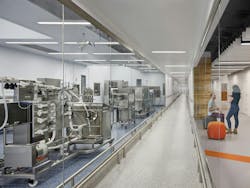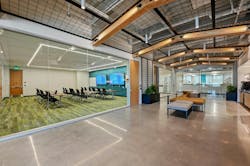Lab space scarcity propels construction demand in life sciences sector
In its 2021 Life Sciences Real Estate Outlook, JLL predicted that access to talent would be a primary concern for an industry sector that had been growing by leaps and bounds. A year later, talent still guides real estate decisions. But market conditions of a different sort were cooling the biotech field: namely, investors that have soured on startups which underperformed after going public.
What this means for new construction and renovation going forward is unpredictable, as the drivers behind life sciences’ surge—demand for new medicines and vaccines at a time when lab space has been scarce—are still palpable. What also hasn’t changed are client expectations for labs, innovation hubs, and science- and research-related projects: design flexibility, amenities that promote collegiality and exposure to the outdoors, and locations with ample access to highly skilled workforces.
AEC firms reiterate variations of these “must haves” when asked about trends in science and technology design and construction. Nancy Escano, AIA, Co-founder and Managing Principal for the architecture design firm DGA, cites “Science on Display” that connects offices and labs, collaboration and adaptability, quiet zones, branding, and amenities that improve tenant satisfaction. Jose Jimenez, Gilbane Building Company’s Vice President–Life Sciences, says his firm’s clients want speed to market, budget certainty, and flexibility within the context of increased demand for manufacturing and research spaces, greater adoption of prefabrication and modular systems, commitment to environmental sustainability, and a focus on intensification and digitization.
Developers “want to come up with a recipe that allows them to market a building as ‘lab ready,’ but also to be able to accommodate a full office tenant if that is where the demand is,” observes Scott Strom, DPR Construction’s Life Science Core Market Leader.
“Flexibility in design allows for spatial enhancements that adapt to future changes,” wrote three execs from the design firm HKS in a blog posted earlier this year that identified five trends shaping life science labs. The authors—Vice President Nancy Constandse, Senior Lab Planner Tom Guiggio, and Regional Practice Director Darcy Royalty—noted that renovations were on the rise, as was demand for innovation hubs that “are becoming more prevalent [in this sector] as people realize how important and influential shared data and findings can be.”
An open runway for life sciences construction
All nine AEC Giants contacted for this article report that their science and tech practices grew during the previous 12 months. “We’ve seen a significant rise in activity,” says Rishi Nandi, AIA, LEED AP, RELi AP, Senior Associate and Senior Project Architect for NBBJ. Nandi adds that his firm has witnessed both considerable speculative demand for new construction, as well as more calls for converting offices, warehouses, and other building types to labs.
Despite signs that demand might be peaking, Strom of DPR says the sector remains robust. Demand for cGMP manufacturing space has been “at an all-time high,” and is being met by sizable investment from contract manufacturing organizations (CMOs) and big pharma companies. On the vaccine front, there are increased facility needs for emerging RNA-based applications and lipid nanoparticle formulation technologies.
Demand for life sciences labs has been expanding beyond the traditional tech corridors into new markets. Over the past year, Skanska saw “notable” expansion of projects into new geographies like Ohio and Texas, says Bryan Northrop, the firm’s Executive Vice President–New England Building Operations. Such demand is due, in part, to supply-chain issues and the desire to return manufacturing to the U.S., he explains. “We are starting to see the planning and construction of large-scale manufacturing facilities with 15,000- to 20,000-liter bioreactors, and companies like Amgen and Johnson & Johnson exploring locations to construct new facilities.”
Building lab space faster
More than three-fifths—62%—of Skanska’s recent life sciences/S+T projects were renovations and additions. Northrop and other AEC sources point out that renovations are often preferable to new construction because the latter takes much longer to get started.
“Speed to market is the primary driver in this sector. Renovation may offer the ability to expedite the construction schedule,” says Gregory T. Smith, Turner Construction’s Vice President of Preconstruction. (That schedule benefit diminishes, he cautions, when projects are phased.)
Adaptive reuse has become a viable alternative to new construction, although Smith notes that many existing buildings aren’t suitable for life science programs without substantial and costly modifications to address vibration mitigation, floor-to-floor heights, and adaptable building cores.
DGA’s Escano agrees. “On a few occasions, we have been approached to look at the repositioning of other types of buildings into life sciences facilities, such as big boxes and even an ice-skating rink. These projects are extremely challenging, and there is uncertainty about how desirable the completed facilities will be.”
That being said, “It’s definitely a trend,” says NBBJ’s Nandi about adaptive reuse. His firm is in the process of converting a ballroom into lab space. Another project, in the U.K., called The Works, was a former auto body shop that NBBJ transformed into a flexible R&D work environment.
In Grove City, Ohio, Skanska is transforming a book storage facility into a 126,000-sf research and biomanufacturing facility that’s part of a multi-phased master plan for Forge Biologics. Scheduled for completion next March, the buildout, designed by BHDP Architecture, is adding 18 new ISO 7 clean rooms, three culture labs, a quality control lab, two 5,000-liter bioreactors, and a new HVAC system. As part of this $76 million project, Skanska is building a two-story structure with 50,000 sf of office space.
“We’ve seen more developers re-evaluating their portfolios and reusing them for life science laboratories and processing facilities,” says John Westphal, an Oakland, Calif.-based Managing Director with Salas O’Brien, the engineering and facilities planning firm. For example, he’s watched suburban developers rebrand one-story warehouses, vacant retail malls, and underperforming commercial assets to tech and research labs.
Michelle Gangel, R&D Segment Leader for the AEC firm CRB, believes that adaptive reuse will become “increasingly necessary” to address supply chain and sustainability issues in this sector. CRB provided lab planning and MEP engineering services for Fulton Labs, a former office building in Chicago’s popular Fulton Market neighborhood that’s now a 14-story, 301,260-sf facility with 11 floors dedicated to leasable lab and office space, and amenities that include a rooftop lounge and beer garden. Modular design and flexible plug-and-play infrastructure allows the lab space to be reconfigured as needed. (CRB completed this project in late 2021 for developer Trammel Crow.)
One of Turner’s recent adaptive reuse projects is The Assembly, a former Ford Motor Company assembly plant in Pittsburgh that a building team led by Wexford Science & Technology and the University of Pittsburgh transformed into a research, innovation, and entrepreneurship hub that added 108,000 sf of new leasable space to the building’s original 250,000 sf. This $330 million project houses labs, offices, a 250-seat auditorium, restaurant and café, and event and conference spaces.
Moving forward, the life science/S+T sector is likely to expand through a mixture of new builds and renovations. DGA has been particularly active in this sector, and its recent projects include the design of Cytokinetics’ seven-story, 235,000-sf headquarters and R&D facility in San Francisco that is opening in phases through next January; tenant improvements to 150,000 sf of Element Biosciences’ headquarters and R&D facility in San Diego, which will be completed in December 2023; and a new campus for Neurocrine Biosciences in Del Mar, Calif., that includes ground-up lab buildings totaling 280,000 sf, tenant improvements on 553,000 sf of existing office space, a new fitness center and interconnected courtyards and outdoor spaces.
ALSO SEE: Giants 400 Science + Technology Sector Rankings:
Science & Technology (S+T) Facilities - All S+T Buildings Work
• Top 100 Science + Technology Facility Architecture and AE Firms
• Top 70 Science + Technology Facility Engineering and EA Firms
• Top 70 Science + Technology Facility Contractors and CM Firms
Science & Technology — Laboratories
• Top 85 Laboratory Facility Architecture and AE Firms
• Top 55 Laboratory Facility Engineering and EA Firms
• Top 45 Laboratory Facility Contractors and CM Firms
Among DPR Construction’s recent work was the fitout of 26,000 sf in an existing warehouse in Arcadia, Calif., for clean rooms and support labs for cell and gene therapy. Its client was Theragent, and the project, designed by Lionakis, was completed last March. For Regenxbio, DPR built out a new 140,000-sf office-and-lab headquarters in a recently completed but unoccupied building in Rockville, Md.
DPR completed this $71 million project, designed by Ewing Cole, on a fast-track schedule. Strom has noticed that clients are showing increased interest in evaluating project delivery and procurement methods “to help them lockup trade contractor capacity and deal with supply-chain and price escalation. Selecting the appropriate delivery method is crucial for increasing the speed to market.”
With speed to market the abiding directive, delivery methods more often include prefab and modular options. “Maximizing offsite prefabrication of specific building systems is another key strategy,” says Gilbane’s Jimenez. His company is the construction manager for the Spagnola/Gisness & Associates-designed Union Square Life Sciences development in Somerville, Mass. Its first phase, which is scheduled for completion next May, is a seven-story, 205,000-sf building whose MEP systems for entire floors are prefabricated, including nearly all the mechanical piping in the penthouse.
To ensure flexibility, one of Skanska’s current S+T projects has a prefabricated panelized ceiling system with stick-built walls, instead of a more conventional panelized system or premanufactured pods. Northrop explains that this method will fully support the ceiling system with non-load bearing walls while allowing the client “to easily change the layout of their manufacturing facility, if necessary.”


